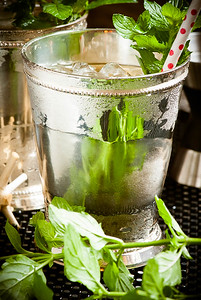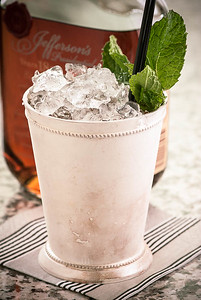The most notable (and infamous) ritual food in my family was the Christmas goose. Oh, how my mother reviled even the smell of that great, fatty, oven-greasing bird; she taught the rest of us to hate it, too, just as she and her sister had for decades. On the other hand, there was my grandmother, matriarch of the family, and for her, roast goose was the one immutable element of Christmas dinner. No goose, no Christmas. So we roasted goose.
The same goes for drinks, of course. Some are really good, like my friend’s once-a-year flurry of Ramos Fizzes on New Year’s Day; some are just goofy, like green beer on St. Patrick’s Day.
One of the greatest ritual drinks of all is the ephemeral Bourbon Mint Julep: we see it one day a year—Kentucky Derby Day, the first Saturday in May—and then it’s gone.
Historians tell us the “julep” (or “julap,” or “julab”) has been around for over a thousand years, but for most of that time, it was a non-alcoholic rose-water infusion used to make medicines more palatable. There’s no mention of alcohol being involved until the late 18th century. William Grimes, in Straight Up or On the Rocks, recounts a British traveler’s correspondence from the 1780s:
“A Virginian of the lower or middle class, wrote an early traveler, ‘rises in the morning, about six o’clock. He drinks a julap, made of rum, water, and sugar, but very strong.'”
As David Wondrich points out in Imbibe!, this is really a description of the original “sling”; our traveler, perhaps with tongue firmly in cheek, chose to call it a “julap,” and soon enough the name stuck.
Most of the elements of the modern Julep, the one we associate with Derby Day and Civil War costume movies, are present in that simple Virginian breakfast drink: spirits, sugar, and water. It wasn’t long before bartenders added the mint, which showed up in the drink around 1800, and the ice, which became popular among the urban upper class in the 1830s.

Icy cold or water warm, the Julep was a very popular drink, and not just in the Old South. It was the stylish drink throughout antebellum America.
But after the Civil War, the Julep’s popularity faded. The 1887 edition of Jerry Thomas’s Bar-tenders Guide already lamented that the drink had become passé, and was already “in its decadence as a public drink.” It seems never to have made a comeback; you and I are likely to encounter it only as that antique, nostalgic, upper-class, Derby Day artifact.
The early, pre-ice formula was simple: two parts water, one part spirits (typically brandy, often whiskey or rum), and a spoonful of sugar. Quick to make, and easy to drink.
The modern version is almost always made with bourbon, sometimes with rye. The formula is pretty well established, which is to say, excellent fodder for ritual, opinion, and argument.
The basic Mint Julep looks like this:
The Bourbon Mint Julep
- 2–2½ oz high-proof bourbon (Weller Antique 107)
- ½ oz simple syrup (Demerara)
- 10–12 fresh mint leaves
- Mint sprigs for garnish
- Dark Jamaican rum for a float (optional)
Press the mint leaves with the sugar in the bottom of a tumbler. Half fill the glass with crushed ice. Add the whiskey, and stir or swizzle until the mix is well chilled. Top up the glass with more crushed ice as needed. Stir or swizzle until the glass begins to frost. Garnish with sprigs of fresh mint. Serve with a straw right next to the mint.
A good high-proof bourbon makes for an excellent Mint Julep. There’s a lot of dilution over time—the Julep is a slow-sipping, contemplative social drink—and the higher proof helps it hold up to the inexorably melting ice and the gradually strengthening mint infusion. I really like the Weller Antique, but any bourbon (or rye) with a proof of 100 or more will be fine. I try to stay away from 80-proof whiskies—they seem to get too thin, too fast.
(The modern idea that the Mint Julep is a whiskey drink wasn’t always the case. As the British traveler’s quote reveals, rum was once a standard ingredient of Juleps, as was brandy. George Kappeler, in his 1895 Modern American Drinks, lists what he calls a “Mint Julep (Southern Style),” which combines half brandy, half rum.)
 The glassware is a conundrum. Modern usage recommends handsome silver cups, which frost up great and show off the family silver—if you got it, flaunt it. But historically, Julep cups were as likely to be glass as silver. In 1862, Jerry Thomas recommended the “large bar-glass;” in 1895, Kappeler suggested “a long thin glass,” which suggests something like a Collins glass. The silver cups were, I suspect, more likely to be part of a homemade Julep—the family silver—and the glassware was more common in commercial bar or club settings. The two serving styles probably represented the difference between public and private consumption.
The glassware is a conundrum. Modern usage recommends handsome silver cups, which frost up great and show off the family silver—if you got it, flaunt it. But historically, Julep cups were as likely to be glass as silver. In 1862, Jerry Thomas recommended the “large bar-glass;” in 1895, Kappeler suggested “a long thin glass,” which suggests something like a Collins glass. The silver cups were, I suspect, more likely to be part of a homemade Julep—the family silver—and the glassware was more common in commercial bar or club settings. The two serving styles probably represented the difference between public and private consumption.
The sweetener: The old recipes specify sugar in various amounts, some more, some less. I use simple syrup because it mixes more easily. I prefer the more complex flavor of Demerara syrup, but it doesn’t really matter very much in the Julep. And of course, the amount depends simply on your own tastes.
The heart of the beast is fresh mint. The mint is the key characteristic of the drink, and the fresher, the better. That’s why this is mainly a summer drink.
Funny thing about Derby Day in Minnesota—there is no mint to be found yet in the garden, it’s all hothouse stuff…
You’ll want plenty of mint on hand, since it goes into the drink to infuse the whiskey, and the prettiest parts get planted as a bouquet on top of the crushed ice. As for the leaves at the bottom of the drink, treat them very gently, just pressing them with a muddler or a spoon. They tend to become bitter if you crush them too much, and they’ll be infusing the drink for quite a while.
The best sprigs you’ll keep for the garnish. Use plenty, to provide a strong, minty nose. (Note that the straw should be placed so the mint will be right under your nose when you sip.)
(Speaking of mint, there’s an item that Wondrich points out from the 1869 Steward and Bar Keeper’s Manual describing the Brandy Julep as “same as the mint Julep, without the mint. It is like the play of Hamlet, with the prince left out.” No one can tell me that old bar books are dry reading.)
 It’s interesting to note the evolution of the Julep’s garnish. Modern Mint Juleps show mint, and nothing else. Nineteenth century Juleps were more ornate: in addition to the bouquet of mint, Thomas also recommended that you “arrange berries, and small pieces of sliced orange on top in a tasty manner, dash with Jamaica rum, and serve with a straw.”
It’s interesting to note the evolution of the Julep’s garnish. Modern Mint Juleps show mint, and nothing else. Nineteenth century Juleps were more ornate: in addition to the bouquet of mint, Thomas also recommended that you “arrange berries, and small pieces of sliced orange on top in a tasty manner, dash with Jamaica rum, and serve with a straw.”
I can do without the berries and oranges, but I love the float. And my garden is full of beautiful mint, so I’m not waiting for Derby Day to come around again. It’s time for a Mint Julep.
“Ritual drinking: the Ephemeral Mint Julep” at cold-glass.com : All text and photos © 2014 Douglas M. Ford. All rights reserved.

Reblogged this on My Blog and commented:
It seems to be an interesting drink.
Superb history and preparation advice for the julep. You just keep getting better and better, Doug!
Thanks, Jake, that’s very uplifting.